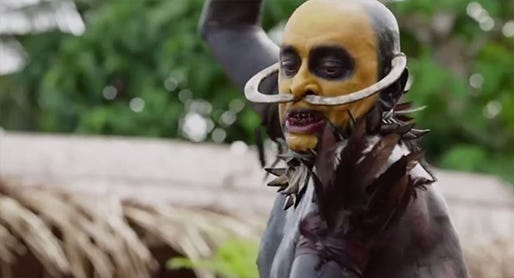The Green Inferno

“The Green Inferno” is repulsive, sadistic, nasty … and mostly a blast if you can give yourself over to the latest bile-spewing B-movie from sick-joke showman Eli Roth — late of “Hostel” and “Cabin Fever,” releasing his first directorial feature since 2007.
Above all else, “Inferno” is Roth’s homage to hardcore Italian-made cannibal films of the ’70s and ’80s, of which there were enough to constitute a Marvel-like cinematic universe. (Their names roll by, RIYL-style, in the closing credits.) Even Roth’s title, incongruous to any incident in his film, comes from the movie-within-a-movie of “Cannibal Holocaust,” allegedly the genre’s capo di tutti capi albeit unseen by me.
It’s also another of Roth’s charnel-house comeuppances for the ugliest of ugly Americanism; see “Hostel,” don’t see the odious “Aftershock.” Here, it’s pretentious college “activists” whose quest for online social-justice glory goes south after their plane crashes just outside a village of cannibals in the Peruvian Amazon. A one-trick pony Roth may be, but damn if he can’t make it run. “It’s like a motorcycle and a rickshaw had a baby!,” one upperclassman squeals at the carts taking them into Peru. “That’s my next tattoo,” another proudly boasts upon sighting a riverside tiger. (Roth’s real-life wife, Lorenza Izzo, and Nicolás Martinez play the only decent folks.)
Will you want to see most of these people eaten? Absolutely, and Roth delivers a relentless hour of body horror, abject humiliation and obsidian humor. Dosing cannibals with weed to knock them out seems a good idea until you forget … the munchies. You can practically hear Roth cackling over the depths to which the group’s louse of a leader, Alejandro (Ariel Levy), sinks, and these bits represent Roth at his satirical shock-and-awe best. You may also no longer look at the foodie trend of fifth-quarter meat with quite such curiosity. Roth says the MPAA gave this an R-rating as is; it’s likely because they didn’t want to sit through it a second time.
Roth’s detractors slag what may seem a bro-like brushoff of xenophobia: Don’t leave the U.S., young Americans, lest the horrors of the world swallow you up. (Only “Aftershock,” which he co-wrote and starred in, abides by such wrongheadedness; really, the degree to which you should avoid “Aftershock” cannot be understated.)
Here, he’s advising caution about who and what in this world, civilized or otherwise, you choose to trust. And he’s poking at how that debate and deliberation has become a minority option in today’s culture of knee-jerk reaction, where angry mobs have swarmed the court of public opinion. Questioning … well, nearly anything about the true nature of altruism gets you labeled a bad person instead of someone who perhaps wishes not to be trolled, duped or exploited. (“Only a freshman would speak with such insolence,” Alejandro scolds as his plan’s effectiveness is disputed.)
Most of the victims in “The Green Inferno” represent a dwindling boundary between actual altruism and the digitally promotional appearance of altruism. Plenty of people out there would envision a trip like this as a resume bullet point or a Timehop to jump to the top of someone’s timeline several years hence. What’s ironic about “The Green Inferno’s” long road to theaters (filmed in 2012 and delayed a year due to distributors’ financial woes) is that its fuming feels freshest right now.
To that end, “Inferno” feels like a social-media revenge fantasy, in which several dozen pounds of flesh are extracted from those defining “activism” as their pound sign rising above anyone else’s. The inclusion of cast-and-crew Twitter handles in the closing credits feels like a final knife twist on that score.
What we don’t see, though, are any actual suggestions on how to really help the Peruvian rainforests Roth has so sumptuously filmed, the villages into which Roth and company embedded themselves, and its residents who populate his movie and whom he so graciously thanks. (Outside of a couple key roles, the villagers are non-professional extras living in the Peruvian Amazon.)
This may seem like discussing real issues at a roast, or the exact opposite of the point Roth is trying to make. But there is an anthropological respect in the film’s quieter (stop laughing) depictions of everyday life in this village. Removed from wildly exaggerated conceits of cannibalism, there’s unspoiled beauty here on whose behalf Roth seems to visually advocate. Instead, he settles on a sophomoric stinger for a sequel that neither he, nor anyone else, is unlikely to make any time soon.
Minor beefs aside, “The Green Inferno” is both a furious, full-stop cannibal horror show and a way for Roth to ferociously gnaw at the meat on the bones he has to pick.


